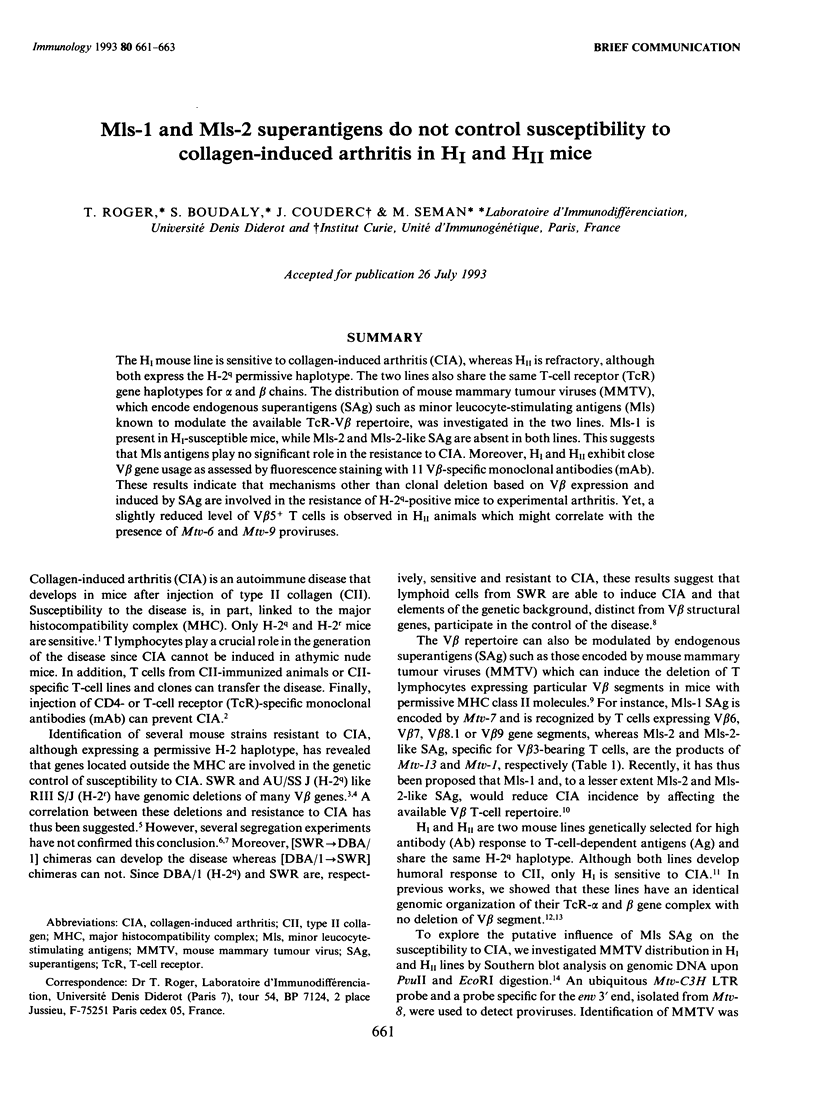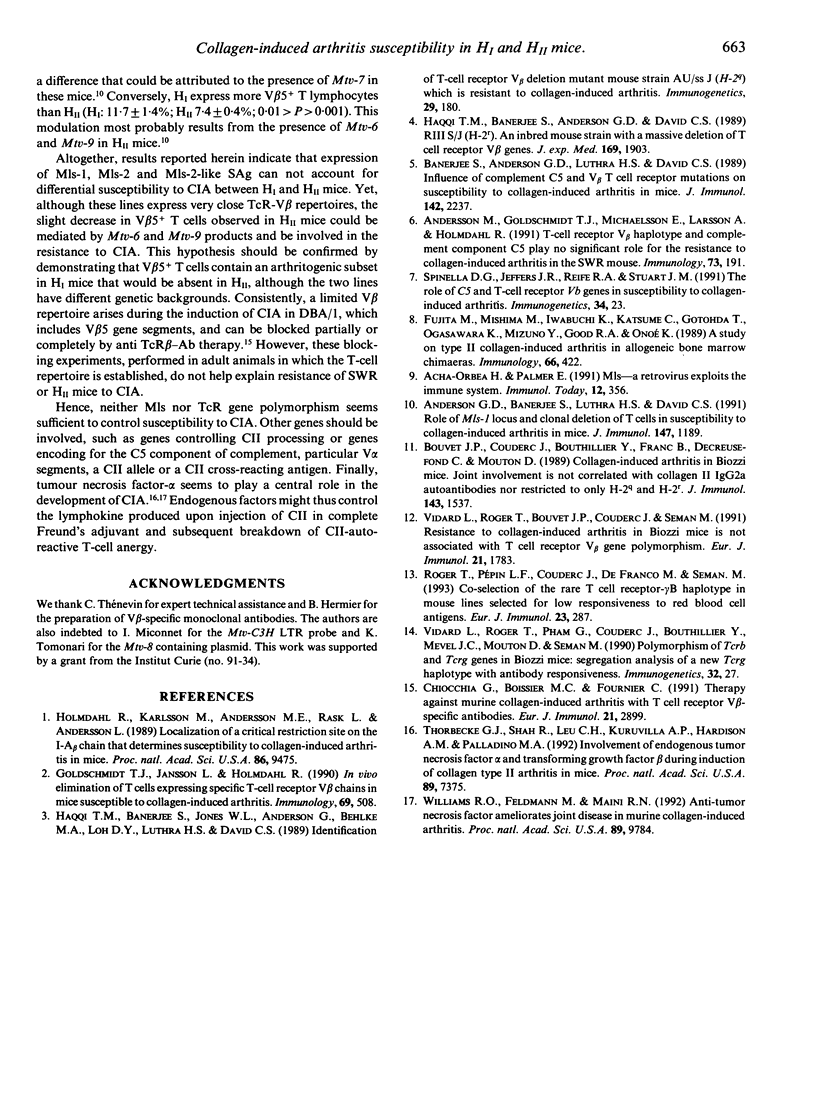Abstract
The HI mouse line is sensitive to collagen-induced arthritis (CIA), whereas HII is refractory, although both express the H-2q permissive haplotype. The two lines also share the same T-cell receptor (TcR) gene haplotypes for alpha and beta chains. The distribution of mouse mammary tumour viruses (MMTV), which encode endogenous superantigens (SAg) such as minor leucocyte-stimulating antigens (Mls) known to modulate the available TcR-V beta repertoire, was investigated in the two lines. Mls-1 is present in HI-susceptible mice, while Mls-2 and Mls-2-like SAg are absent in both lines. This suggests that Mls antigens play no significant role in the resistance to CIA. Moreover, HI and HII exhibit close V beta gene usage as assessed by fluorescence staining with 11 V beta-specific monoclonal antibodies (mAb). These results indicate that mechanisms other than clonal deletion based on V beta expression and induced by SAg are involved in the resistance of H-2q-positive mice to experimental arthritis. Yet, a slightly reduced level of V beta 5+ T cells is observed in HII animals which might correlate with the presence of Mtv-6 and Mtv-9 proviruses.
Full text
PDF


Images in this article
Selected References
These references are in PubMed. This may not be the complete list of references from this article.
- Acha-Orbea H., Palmer E. Mls--a retrovirus exploits the immune system. Immunol Today. 1991 Oct;12(10):356–361. doi: 10.1016/0167-5699(91)90066-3. [DOI] [PubMed] [Google Scholar]
- Anderson G. D., Banerjee S., Luthra H. S., David C. S. Role of Mls-1 locus and clonal deletion of T cells in susceptibility to collagen-induced arthritis in mice. J Immunol. 1991 Aug 15;147(4):1189–1193. [PubMed] [Google Scholar]
- Banerjee S., Anderson G. D., Luthra H. S., David C. S. Influence of complement C5 and V beta T cell receptor mutations on susceptibility to collagen-induced arthritis in mice. J Immunol. 1989 Apr 1;142(7):2237–2243. [PubMed] [Google Scholar]
- Bouvet J. P., Couderc J., Bouthillier Y., Franc B., Decreusefond C., Mouton D. Collagen-induced arthritis in Biozzi mice. Joint involvement is not correlated with collagen II IgG2a autoantibodies nor restricted to only H-2q and H-2r. J Immunol. 1989 Sep 1;143(5):1537–1542. [PubMed] [Google Scholar]
- Chiocchia G., Boissier M. C., Fournier C. Therapy against murine collagen-induced arthritis with T cell receptor V beta-specific antibodies. Eur J Immunol. 1991 Dec;21(12):2899–2905. doi: 10.1002/eji.1830211202. [DOI] [PubMed] [Google Scholar]
- Fujita M., Mishima M., Iwabuchi K., Katsume C., Gotohda T., Ogasawara K., Mizuno Y., Good R. A., Onoé K. A study on type II collagen-induced arthritis in allogeneic bone marrow chimaeras. Immunology. 1989 Mar;66(3):422–427. [PMC free article] [PubMed] [Google Scholar]
- Goldschmidt T. J., Jansson L., Holmdahl R. In vivo elimination of T cells expressing specific T-cell receptor V beta chains in mice susceptible to collagen-induced arthritis. Immunology. 1990 Apr;69(4):508–514. [PMC free article] [PubMed] [Google Scholar]
- Haqqi T. M., Banerjee S., Anderson G. D., David C. S. RIII S/J (H-2r). An inbred mouse strain with a massive deletion of T cell receptor V beta genes. J Exp Med. 1989 Jun 1;169(6):1903–1909. doi: 10.1084/jem.169.6.1903. [DOI] [PMC free article] [PubMed] [Google Scholar]
- Haqqi T. M., Banerjee S., Jones W. L., Anderson G., Behlke M. A., Loh D. Y., Luthra H. S., David C. S. Identification of T-cell receptor V beta deletion mutant mouse strain AU/ssJ (H-2q) which is resistant to collagen-induced arthritis. Immunogenetics. 1989;29(3):180–185. doi: 10.1007/BF00373643. [DOI] [PubMed] [Google Scholar]
- Holmdahl R., Karlsson M., Andersson M. E., Rask L., Andersson L. Localization of a critical restriction site on the I-A beta chain that determines susceptibility to collagen-induced arthritis in mice. Proc Natl Acad Sci U S A. 1989 Dec;86(23):9475–9479. doi: 10.1073/pnas.86.23.9475. [DOI] [PMC free article] [PubMed] [Google Scholar]
- Roger T., Pépin L. F., Couderc J., De Franco M., Seman M. Co-selection of the rare T cell receptor-gamma B haplotype in mouse lines selected for low responsiveness to red blood cell antigens. Eur J Immunol. 1993 Jan;23(1):287–290. doi: 10.1002/eji.1830230146. [DOI] [PubMed] [Google Scholar]
- Thorbecke G. J., Shah R., Leu C. H., Kuruvilla A. P., Hardison A. M., Palladino M. A. Involvement of endogenous tumor necrosis factor alpha and transforming growth factor beta during induction of collagen type II arthritis in mice. Proc Natl Acad Sci U S A. 1992 Aug 15;89(16):7375–7379. doi: 10.1073/pnas.89.16.7375. [DOI] [PMC free article] [PubMed] [Google Scholar]
- Vidard L., Roger T., Bouvet J. P., Couderc J., Seman M. Resistance to collagen-induced arthritis in Biozzi mice is not associated with T cell receptor V beta gene polymorphism. Eur J Immunol. 1991 Jul;21(7):1783–1785. doi: 10.1002/eji.1830210733. [DOI] [PubMed] [Google Scholar]
- Vidard L., Roger T., Pham G., Couderc J., Bouthillier Y., Mevel J. C., Mouton D., Seman M. Polymorphism of Tcrb and Tcrg genes in Biozzi mice: segregation analysis of a new Tcrg haplotype with antibody responsiveness. Immunogenetics. 1990;32(1):27–33. doi: 10.1007/BF01787325. [DOI] [PubMed] [Google Scholar]
- Williams R. O., Feldmann M., Maini R. N. Anti-tumor necrosis factor ameliorates joint disease in murine collagen-induced arthritis. Proc Natl Acad Sci U S A. 1992 Oct 15;89(20):9784–9788. doi: 10.1073/pnas.89.20.9784. [DOI] [PMC free article] [PubMed] [Google Scholar]




